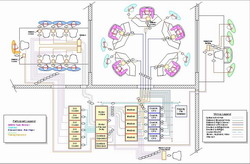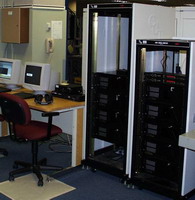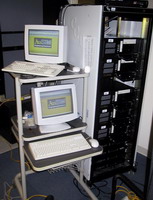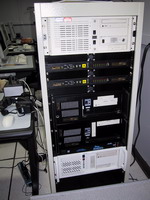

|
| Home < Products < Voice Communications < MVP Series | ||||
|
Voice Communication Systems
MVP Series |
||||
|
The AuSIM Multi-Voice Presence System (MVP)
is a configuration of one or more GoldServers with an AuSIM CircuitManager.
MVP systems are easily configured to meet your requirements.
One example MVP system which AuSIM has deployed was for the Multi-Modal Watch Station (MMWS), an advanced surface ship Command, Control, Communications, and Intelligence (C3I) console developed for DD-X (21st century Navy destroyer class) by the Navy's SPAWAR Systems Center in San Diego. Some of the features of this system are given below. |
||||
|
Multi-Modal Watch Station (MMWS) MMWS supported five (5) command officers, five (5) evaluators, five (5) observers, a simulation supervisor, and six (6) role-players. Upon delivery in 2000, the system required nine (9) AuSIM3D servers and six (6) AuSIM clients to provide this facility. Today, all of this, without compromise (the MMWS role-players listened to simple stereo rather than full 3D audio) can be delivered on only two AuSIM3D servers. Each officer monitored 2 external nets (selectable from a virtual unlimited number) as well as net-15 (intercom), had a dedicated channel for point-to-point full-duplex conversations (where they could choose any endpoint in the system), and had dedicated channels for message replay and alerts. In a summary worst case, an officer could be presented with 7 simultaneous sound events. |

MMWS Schematic |
|||

|
The comms are organized as "nets" (virtual groups) and not as individual voices. Thus, the sound sources were positioned by task. It may be argued that this grouping diminishes an advantage of 3D audio ... it is confusing when BravoWhiskey first talks on TF/TG CMD which comes from in-front, and then talks on Net-15 which comes from in-back. The talker identification via location-consistency is lost. The MMWS designers maintained that grouping by task (each net represents a task) was more effective to the officer. | |||
| Additional features included: | ||||
|
|
|||


 
|
||||
|
|
||

|
[Home] [About AuSIM] [Products] [Services] [Applications] |
|
| [Support] [Contacts] [Buy Online] [Downloads] [News & Events] | ||
| © AuSIM Inc. 1998-2011. Last updated on | ||